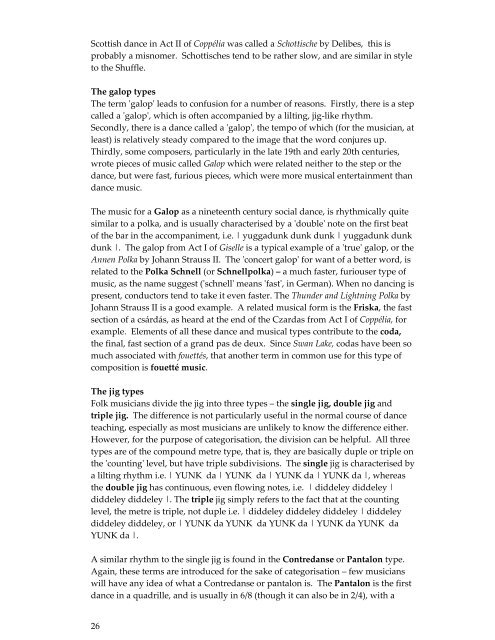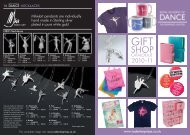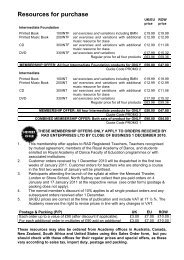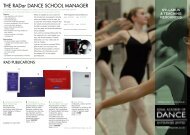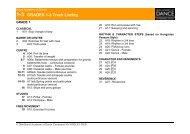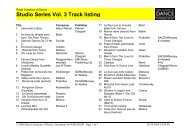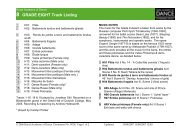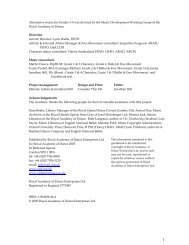Music in Focus guidebook to Alternative Music for Grades 1-3
Music in Focus guidebook to Alternative Music for Grades 1-3
Music in Focus guidebook to Alternative Music for Grades 1-3
Create successful ePaper yourself
Turn your PDF publications into a flip-book with our unique Google optimized e-Paper software.
Scottish dance <strong>in</strong> Act II of Coppélia was called a Schottische by Delibes, this is<br />
probably a misnomer. Schottisches tend <strong>to</strong> be rather slow, and are similar <strong>in</strong> style<br />
<strong>to</strong> the Shuffle.<br />
The galop types<br />
The term ʹgalopʹ leads <strong>to</strong> confusion <strong>for</strong> a number of reasons. Firstly, there is a step<br />
called a ʹgalopʹ, which is often accompanied by a lilt<strong>in</strong>g, jig‐like rhythm.<br />
Secondly, there is a dance called a ʹgalopʹ, the tempo of which (<strong>for</strong> the musician, at<br />
least) is relatively steady compared <strong>to</strong> the image that the word conjures up.<br />
Thirdly, some composers, particularly <strong>in</strong> the late 19th and early 20th centuries,<br />
wrote pieces of music called Galop which were related neither <strong>to</strong> the step or the<br />
dance, but were fast, furious pieces, which were more musical enterta<strong>in</strong>ment than<br />
dance music.<br />
The music <strong>for</strong> a Galop as a n<strong>in</strong>eteenth century social dance, is rhythmically quite<br />
similar <strong>to</strong> a polka, and is usually characterised by a ʹdoubleʹ note on the first beat<br />
of the bar <strong>in</strong> the accompaniment, i.e. | yuggadunk dunk dunk | yuggadunk dunk<br />
dunk |. The galop from Act I of Giselle is a typical example of a ʹtrueʹ galop, or the<br />
Annen Polka by Johann Strauss II. The ʹconcert galopʹ <strong>for</strong> want of a better word, is<br />
related <strong>to</strong> the Polka Schnell (or Schnellpolka) – a much faster, furiouser type of<br />
music, as the name suggest (ʹschnellʹ means ʹfastʹ, <strong>in</strong> German). When no danc<strong>in</strong>g is<br />
present, conduc<strong>to</strong>rs tend <strong>to</strong> take it even faster. The Thunder and Lightn<strong>in</strong>g Polka by<br />
Johann Strauss II is a good example. A related musical <strong>for</strong>m is the Friska, the fast<br />
section of a csárdás, as heard at the end of the Czardas from Act I of Coppélia, <strong>for</strong><br />
example. Elements of all these dance and musical types contribute <strong>to</strong> the coda,<br />
the f<strong>in</strong>al, fast section of a grand pas de deux. S<strong>in</strong>ce Swan Lake, codas have been so<br />
much associated with fouettés, that another term <strong>in</strong> common use <strong>for</strong> this type of<br />
composition is fouetté music.<br />
The jig types<br />
Folk musicians divide the jig <strong>in</strong><strong>to</strong> three types – the s<strong>in</strong>gle jig, double jig and<br />
triple jig. The difference is not particularly useful <strong>in</strong> the normal course of dance<br />
teach<strong>in</strong>g, especially as most musicians are unlikely <strong>to</strong> know the difference either.<br />
However, <strong>for</strong> the purpose of categorisation, the division can be helpful. All three<br />
types are of the compound metre type, that is, they are basically duple or triple on<br />
the ʹcount<strong>in</strong>gʹ level, but have triple subdivisions. The s<strong>in</strong>gle jig is characterised by<br />
a lilt<strong>in</strong>g rhythm i.e. | YUNK da | YUNK da | YUNK da | YUNK da |, whereas<br />
the double jig has cont<strong>in</strong>uous, even flow<strong>in</strong>g notes, i.e. | diddeley diddeley |<br />
diddeley diddeley |. The triple jig simply refers <strong>to</strong> the fact that at the count<strong>in</strong>g<br />
level, the metre is triple, not duple i.e. | diddeley diddeley diddeley | diddeley<br />
diddeley diddeley, or | YUNK da YUNK da YUNK da | YUNK da YUNK da<br />
YUNK da |.<br />
A similar rhythm <strong>to</strong> the s<strong>in</strong>gle jig is found <strong>in</strong> the Contredanse or Pantalon type.<br />
Aga<strong>in</strong>, these terms are <strong>in</strong>troduced <strong>for</strong> the sake of categorisation – few musicians<br />
will have any idea of what a Contredanse or pantalon is. The Pantalon is the first<br />
dance <strong>in</strong> a quadrille, and is usually <strong>in</strong> 6/8 (though it can also be <strong>in</strong> 2/4), with a<br />
26


